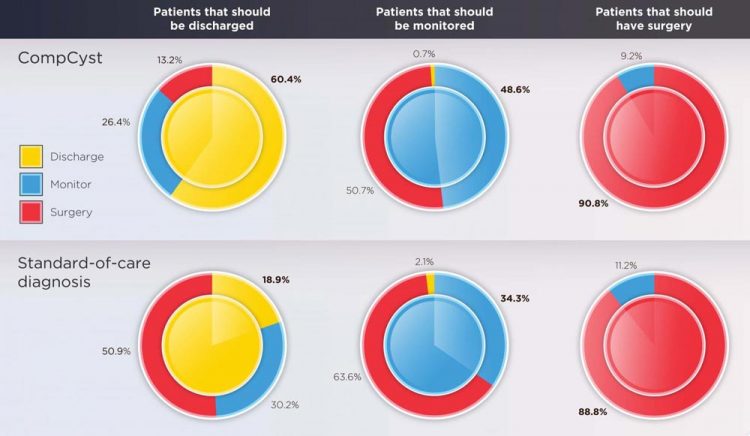Machine learning platform guides pancreatic cyst management in patients

The two sets of charts compare the recommendations for managing patients with pancreatic cysts based on either CompCyst or standard-of-care pathology. This material relates to a paper that appeared in the Jul. 17, 2019, issue of Science Translational Medicine, published by AAAS. The paper, by S. Springer at Howard Hughes Medical Institute in Baltimore, MD; and colleagues was titled, 'A multimodality test to guide the management of patients with a pancreatic cyst.' Credit: S. Springer et al., Science Translational Medicine (2019) Usage Restrictions: Please cite the owner of the material when publishing. This material may be freely used by reporters as part of news coverage, with proper attribution. Non-reporters must contact Science for permission.
The new assay, called CompCyst, outperformed the current gold standard-of-care in an international, multicenter study of 875 patients. Crucially, the test would have avoided surgery in 60% of patients who underwent unnecessary surgical removal, suggesting its use could lead to fewer unneeded surgeries and lower health and economic costs.
Pancreatic cysts are fluid-filled lesions in the pancreas that are found in up to 8% of all people over the age of 70. Although most cysts are benign, some pancreatic cysts that produce mucin can transform into an aggressive form of pancreatic cancer.
What's more, it is difficult to distinguish precancerous cysts from benign ones, so noncancerous cysts are often misclassified and unnecessarily removed with pancreatic surgery.
To overcome this dilemma, Simeon Springer and colleagues enrolled 875 patients with pancreatic cysts and collected information of the mutations, proteins, and other markers linked to their either benign or mucin-producing cysts.
They used deep learning techniques to train CompCyst to read these markers and classify patients into those that should be monitored, not monitored, or receive surgery.
After training the test protocol with 436 of the original patients, the researchers found the test largely outperformed standard-of-care pathology when evaluated in 426 other patients: it correctly identified 60.4% of patients who should have been discharged (versus 18.9% using standard-of-care diagnosis), 48.6% of patients that should have been monitored (versus 34.3%), and 90.8% of patients in need of surgery (versus 88.8%).
Future work will be necessary to prospectively validate the markers used in the test, but Springer et al. say their platform has strong potential to be used in the clinic as a complement to existing approaches.
Media Contact
More Information:
http://dx.doi.org/10.1126/scitranslmed.aav4772All latest news from the category: Health and Medicine
This subject area encompasses research and studies in the field of human medicine.
Among the wide-ranging list of topics covered here are anesthesiology, anatomy, surgery, human genetics, hygiene and environmental medicine, internal medicine, neurology, pharmacology, physiology, urology and dental medicine.
Newest articles

Properties of new materials for microchips
… can now be measured well. Reseachers of Delft University of Technology demonstrated measuring performance properties of ultrathin silicon membranes. Making ever smaller and more powerful chips requires new ultrathin…

Floating solar’s potential
… to support sustainable development by addressing climate, water, and energy goals holistically. A new study published this week in Nature Energy raises the potential for floating solar photovoltaics (FPV)…

Skyrmions move at record speeds
… a step towards the computing of the future. An international research team led by scientists from the CNRS1 has discovered that the magnetic nanobubbles2 known as skyrmions can be…





















